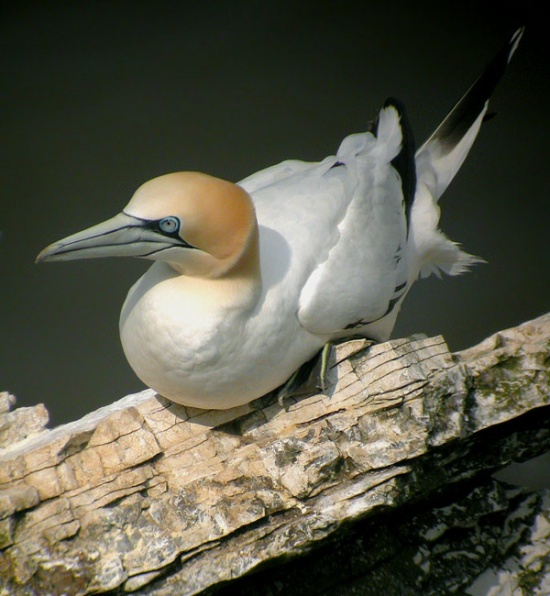
- Morus bassanus
Identification
L. 87-100cm Ws. 165-180cm
Adult
- White with black wingtips
- Light blue bill
- Bare, black skin around eye
- During breeding, head and neck are brushed with pale yellow
Immature Dark brown in their first year, and gradually acquire more white in subsequent seasons until they reach maturity after five years.
Distribution
Over 70% of the world population of Northern Gannet breed in more than 20 colonies around the coasts of the British Isles and in particular off north and west Scotland. The world's largest gannetry is on St Kilda with over 50,000 pairs. There are also colonies on the Flannan Islands to the west of the Outer Hebrides, further north on remote Sula Sgeir, and Sule Stack to the west of the Orkneys.
Shetland has long-established colonies on Noss (around 8,500 breeding pairs) and Hermaness with more recent breeding on Foula and Fair Isle. Further south in Scotland there are large gannetries on Bass Rock in the east and Ailsa Craig in the west and two smaller, more recently established colonies on Scar Rocks off the Mull of Galloway and Troup Head, Grampian. England's only remaining colony is on Bempton Cliffs, North Yorkshire and the single Welsh site is the island of Grassholm, off Dyfed where more than 30,000 nest.
Ireland has five gannetries, Little Skellig off County Kerry is the largest with more than 20,000, Bull Rock , County Cork and Great Saltee, County Wexford are much smaller with less than 2,000 each, and the smallest are Clare Island, County Mayo and the newly-founded Ireland's Eye colony off County Dublin.
In the English Channel there are breeding Gannets on Ortac and Les Etacs off Alderney in the Channel Islands and the most southerly colony in Europe is on Ile Rouzic in the Sept Iles off Brittany.
Elsewhere in Europe there are six gannetries in Iceland including the Westmann Islands, one on Mykinesholmur in the Faroes and 6-7 in Norway. All the Norwegian gannetries are relatively recently established and include Norway's first, at Runde in the south and the world's most northerly, at Syltefjordstauran. One in the Lofoten Islands has been abandoned probably through persecution. Breeding has recently occurred for the first time on the Murman coast of Russia and the first breeding for Germany took place on Heligoland in 1991 with more than 90 pairs by 2000. In 1996 the first breeding in the Mediterranean occurred at Bendol, Var in southern France.
In North America breeds mainly on the Gaspe Peninsula of Quebec and Newfoundland.
After breeding Gannets disperse, some remain at sea within breeding latitudes but others move south to Biscay, off Iberia and south to West African waters. In winter also found in the Mediterranean, mainly east to Italy but a few wander as far as Cyprus and beyond.
North America birds winter on the eastern seaboard from New Jersey south to Florida and in the eastern Gulf of Mexico.
Vagrants recorded north to Svalbard, the Baltic States and Poland and even to land-locked countries such as Austria and Switzerland.
Taxonomy
This is a monotypic species[1].
Habitat
Breeding colonies are located on isolated stacks or remote islands, sometimes on mainland cliffs. At sea when not breeding, over continental shelf. Occasionally on large inland waters as a result of severe weather.
Behaviour
Diving from a height of around 30 metres or less, and hitting the water at anything up to 70mph, many birds go blind at a young age, from diving into the water.
Diet
Includes small fish, which it takes from a steep, high-speed dive.
Breeding
Colonial nesters, the nest is a pile of mud, topped with grass or other vegetation on a steep cliff face. They lay a single pale blue egg.
Vocalisation
<flashmp3>06 - Sulidae- Northern Gannet.mp3</flashmp3>
Listen in an external program
In Culture
In Shetland dialect, they are known as the 'Solan Goose'.
References
- Clements, JF. 2009. The Clements Checklist of Birds of the World. 6th ed., with updates to December 2009. Ithaca: Cornell Univ. Press. ISBN 978-0801445019.
- All About BIrds
Recommended Citation
- BirdForum Opus contributors. (2024) Northern Gannet. In: BirdForum, the forum for wild birds and birding. Retrieved 21 December 2024 from https://www.birdforum.net/opus/Northern_Gannet
External Links



